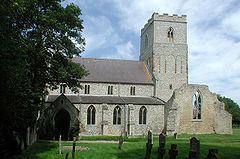OS grid reference TF7226 | Sovereign state United Kingdom Dialling code 01485 | |
 | ||
Population 276 (parish, 2011 census) Civil parish Flitcham with Appleton CP District King's Lynn and West Norfolk | ||
Flitcham is a village within the civil parish of Flitcham with Appleton in the English county of Norfolk. The village is 45.5 miles (73.2 km) north-west of Norwich, 9.1 miles (14.6 km) north-east of King’s Lynn and 112 miles (180 km) north of London. The village straddles the B1153 road just to the north of the A148 Fakenham Road at Hillington. The nearest railway station is at King’s Lynn for the Fen Line which runs between King’s Lynn and Cambridge. The parish of Flitcham with Appleton in the 2011 census, had a population of 276 in 121 households. For the purposes of local government, the parish falls within the district of King's Lynn and West Norfolk. Together with the villages of West Newton, Shernborne, and Anmer, it is part of the Royal Sandringham Estate.
Contents
- Map of Flitcham Kings Lynn UK
- Description
- Roman Occupation
- Anglo Saxon period
- The Domesday Book
- Notable people
- References
Map of Flitcham, King's Lynn, UK
Description
The parish of Flitcham with Appleton within which the village is located is a large parish which is in the north west of Norfolk. To the east the parish boundary is discernible by the route of the Peddars Way, the long distance footpath which follows the route of a Roman road. On the southern boundary is the River Babingley whose source is close to the village and runs to the River Great Ouse at Wootton Marshes. The northern boundary is with the civil parish of Anmer, whilst the parish and royal estate of Sandringham lie to the west. The village of Flitcham is in the south of the parish. Also within the parish is the hamlet of Appleton, a lost village which has now dwindled to a few dwellings and a church in a ruinous state. The name Flitcham derives from the Old English meaning a homstead or village where flitches of bacon are produced.
Roman Occupation
Evidence has found that there was substantial settlement within the parish during the period of Roman occupation in Norfolk. In 1940 archeologist found a villa and bath house on slopes overlooking smaller settlements in the river Babingley valley. These substantial buildings were found in Denbeck Wood, a little north west of Flitcham near Appleton. The excavations revealed the main house, which had glazed windows and a tessellated floor, and a courtyard surrounded by small buildings along with the bath house which had pink painted wall plaster. The dig also found a number of Roman artefacts which included coins, pottery, brooches and other metalwork dating from the 3rd to the early 4th centuries. Another building was discovered near Flitcham Hall on the northern side of Common Drove. On this site, pottery, flue tiles and other architectural fragments were unearthed. These two buildings are part of a group of villas in the area, including others at Congham and Gayton.
Anglo-Saxon period
During the excavations of the Denbeck Wood villa other artefacts were found from the Anglo-Saxon period. These included early Anglo-Saxon pottery, brooches and other metalwork, as well as Middle and Late Anglo-Saxon pottery and metalwork.
The Domesday Book
Flitcham has an entry in the Domesday Book of 1085 where its population, land ownership and productive resources were extensively detailed In the survey Flitcham is recorded by the name of Flicham, Phlicham and Plic(e)ham. The main tenants being the Bishop of Bayeux, William de Warenne and Robert and Ranulf Fitz Walter from Roger Bigot. The survey also listed 4 mills, a church, 3 acres (12,000 m2) of meadow, paunage for 27 swine, 3 cows, 1 beast for carriage and 180 sheep. In the Domesday book the size of woodland was normally given as the number of swine a wood could support in this case 27 pigs.
Notable people
Olav V (2 July 1903 – 17 January 1991) who was the King of Norway from 1957, was born in Appleton House in Flitcham to Prince Carl of Denmark and Princess Maud, the daughter of King Edward VII). He he was given the names and title of Alexander Edward Christian Frederik, Prince of Denmark. He was given the name Olav when his father became King Haakon VII of Norway in 1905.
Together with the villages of West Newton, Shernborne, and Anmer, it is part of the Royal Sandringham Estate.
